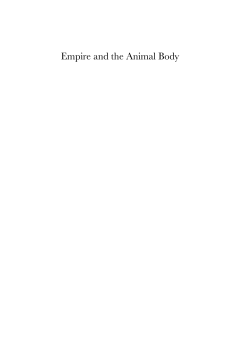
Additional Information
Book Details
Abstract
‘Empire and the Animal Body: Violence, Identity and Ecology in Victorian Adventure Fiction’ explores representations of exotic animals in Victorian adventure fiction, mainly in works by R. M. Ballantyne, G. A. Henty, G. M. Fenn, Paul du Chaillu, H. Rider Haggard and John Buchan. These primary texts are concerned with Southern and West Africa, India and what is now Indonesia in the period 1860–1910, an era which comprises imperial expansion, consolidation and the beginnings of imperial decline. Representations of exotic animals in such literary works generally revolve around portrayals of violence, either in big-game hunting or in the collection of scientific specimens, and draw on a range of literary sources, most notably romance, natural history writing and ‘penny dreadful’ fiction.
This study investigates how these texts’ depictions of forms of violence complicate the seemingly fundamental distinction of humans from animals, and undermines the ideological structures of imperial rule. Rather than an innate and hierarchical opposition, the relationship of humans with their animal others emerges in this context as a complex interplay of kinship and difference. This argument both continues the postcolonial dismantling of empire’s logic of domination and develops the recentering of the nonhuman in environmentally focused criticism. Most vitally, it also signals the relation between these fields: the necessary interdependence of human and nonhuman interests, environmental activism and global social justice.
John Miller is currently a lecturer in nineteenth-century literature at the University of Sheffield. He has published widely on animal studies and ecocriticism, particularly in relation to British Empire writing and postcolonial studies.
‘Using ideas from animal studies and ecocriticism, Miller reveals the late nineteenth- and early twentieth-century genre of imperial romance to be a crucial and fascinating site of anxiety about that being called the human. “Empire and the Animal Body” will be essential reading for everyone interested in thinking about how we live in the world: who it is that we have been and who it is that we are today.’ —Professor Erica Fudge, University of Strathclyde
‘An excellent inquiry into the inscription of environmental violence in imperial adventure fiction and its bearings on the genre’s popularity. Lucid, rigorous and assured, it promises to be a foundational text at the juncture of Victorian studies, ecocriticism and colonial history.’ —Dr Anthony Carrigan, Keele University
‘[Miller] discusses the experience of the hunt as domination of the Other, big game as and economic resource, and the attempts to regulate the disappearance of endangered species, which often resulted in increased control over colonial subjects.’ —Adela Pinch, ‘Studies in English Literature’
‘Empire and the Animal Body: Violence, Identity and Ecology in Victorian Adventure Fiction’ develops recent work in animal studies, eco-criticism and postcolonial studies to reassess the significance of exotic animals in Victorian adventure literature. Depictions of violence against animals were integral to the ideology of adventure literature in the late nineteenth and early twentieth centuries. However, the evolutionary hierarchies on which such texts relied were complicated by developing environmental sensitivities and reimaginings of human selfhood in relation to animal others. As these texts hankered after increasingly imperilled areas of wilderness, the border between human and animal appeared tense, ambivalent and problematic.
‘A compelling and original contribution to its deftly combined fields of study. Miller tracks the fascinatingly unstable division between human/animal identity as it emerges in late Victorian adventure writing, examining its effects on the overlapping rhetoric of racism, speciesism and colonialism at the height of Britain’s empire.’ —Dr Christine Ferguson, University of Glasgow
Table of Contents
| Section Title | Page | Action | Price |
|---|---|---|---|
| Half Title | i | ||
| Title | iii | ||
| Copyright | iv | ||
| CONTENTS | v | ||
| LIST OF ILLUSTRATIONS | vii | ||
| ACKNOWLEDGEMENTS | ix | ||
| INTRODUCTION | 1 | ||
| Historical Overview | 6 | ||
| Opposing Interests | 12 | ||
| Some Problems of Intersectionalism | 15 | ||
| Chapter Summary | 18 | ||
| Chapter One OTHERNESS AND ORDER | 23 | ||
| Imperial Adventures | 23 | ||
| Political Animals | 32 | ||
| Trophies and Trinkets | 46 | ||
| Chapter Two SCIENTISTS AND SPECIMENS | 57 | ||
| Truth’s Body | 57 | ||
| Boy’s Own Science and the Meanings of Violence | 68 | ||
| In Search of Nature’s Treasures | 78 | ||
| Animal Magic | 87 | ||
| Chapter Three THE ANIMAL WITHIN | 97 | ||
| Gorilla War | 97 | ||
| Errors and Accusations | 108 | ||
| Further Confusion | 121 | ||
| In the Mud | 133 | ||
| Chapter Four WILD MEN AND WILDERNESS | 149 | ||
| Artificial Lives | 149 | ||
| Metamorphosis | 158 | ||
| A Perpetual Fever | 168 | ||
| CONCLUSION | 183 | ||
| NOTES | 191 | ||
| Introduction | 191 | ||
| Chapter One: Otherness and Order | 194 | ||
| Chapter Two: Scientists and Specimens | 198 | ||
| Chapter Three: The Animal Within | 202 | ||
| Chapter Four: Wild Men and Wilderness | 206 | ||
| Conclusion | 209 | ||
| BIBLIOGRAPHY | 211 | ||
| INDEX | 229 |
